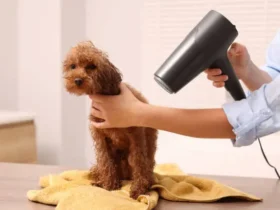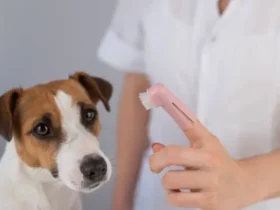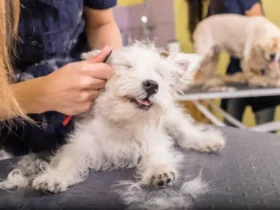eterinarian Courtney Campbell’s Tips for Bathing and Brushing Your Dog
Keeping your dog clean and well-groomed is essential for their health and happiness. While it may seem straightforward, bathing and brushing your dog requires more than just soap and water. According to Veterinarian Courtney Campbell, proper techniques and tools can make a world of difference in maintaining your dog’s coat and skin health. Below, we delve into Campbell’s expert advice on how to best bathe and brush your dog, ensuring a stress-free experience for both you and your furry friend.
1. Understanding Your Dog’s Coat Type
- Why It Matters: Different breeds have different coat types, which require specific grooming methods. Understanding your dog’s coat type is the first step in choosing the right products and tools.
- Common Coat Types:
- Short-haired breeds: Labradors, Beagles
- Long-haired breeds: Shih Tzus, Collies
- Curly-haired breeds: Poodles, Bichon Frises
- Double-coated breeds: Huskies, Golden Retrievers
- Campbell’s Advice: “Identify your dog’s coat type and consult with your vet or a professional groomer to select the best products.”
2. Pre-Bath Preparation
- Brushing Before Bathing: Campbell stresses the importance of brushing your dog’s coat before a bath. This helps remove loose hair, dirt, and mats, which can be more difficult to handle once the coat is wet.
- Detangling Tools: Use a wide-tooth comb or a slicker brush to gently detangle any knots.
- Ear Protection: To prevent water from entering your dog’s ears, place cotton balls in their ears. This helps avoid ear infections.
- Nail Trimming: Trimming your dog’s nails before the bath is recommended to avoid scratches and to make the grooming process smoother.
3. Choosing the Right Shampoo and Conditioner
- Shampoo Selection: Campbell emphasizes using a dog-specific shampoo. Human shampoos can disrupt a dog’s pH balance and irritate their skin. Look for shampoos that cater to your dog’s specific needs (e.g., hypoallergenic, medicated).
- Conditioner: A good conditioner can help keep your dog’s coat smooth and shiny. It’s particularly beneficial for long-haired and curly-haired breeds.
- Campbell’s Tip: “Always read the ingredient list and avoid products with harsh chemicals or strong fragrances.”
4. Bathing Techniques
- Water Temperature: The water should be lukewarm. Too hot or too cold water can cause discomfort or even shock to your dog.
- Starting the Bath: Wet your dog’s coat thoroughly, starting from the neck down. Avoid getting water in their eyes, ears, or nose.
- Lathering: Use a small amount of shampoo and lather it well, focusing on the body, underbelly, legs, and tail. Be gentle around the face and avoid direct application near the eyes.
- Rinsing: Rinse thoroughly to ensure no shampoo residue remains, as it can irritate the skin.
- Drying: Gently towel dry your dog. For long-haired breeds, a blow dryer on a low, cool setting can help speed up the process.
5. Post-Bath Brushing
- Why It’s Important: Brushing after a bath helps remove any remaining loose hair and ensures the coat dries properly without matting.
- Tools to Use: Use a brush suitable for your dog’s coat type. For short-haired breeds, a bristle brush works well, while long-haired breeds may require a pin brush or slicker brush.
- Campbell’s Recommendation: “Be thorough but gentle, as the skin can be more sensitive after a bath.”
6. Addressing Common Issues
- Dealing with Shedding: If your dog sheds heavily, consider using a de-shedding tool or a specialized brush like the Furminator. Regular brushing can significantly reduce the amount of hair left around your home.
- Handling Matting: For dogs prone to matting, daily brushing is essential. For severe mats, consider seeking professional grooming assistance to avoid hurting your dog.
- Skin Irritations: Watch for signs of skin irritation such as redness, bumps, or excessive scratching. If you notice these, discontinue use of the product and consult your vet.
7. Making Bath Time Enjoyable
- Positive Reinforcement: Campbell suggests using treats and praise to create a positive association with bath time. This can help reduce your dog’s anxiety and make the process smoother.
- Toys and Distractions: Introduce toys or a peanut butter-filled treat during bath time to keep your dog occupied.
- Routine: Establishing a regular bath schedule helps your dog get accustomed to the process. Depending on the breed and lifestyle, baths are typically recommended every 4-6 weeks.
8. Special Considerations
- Puppies: Campbell advises extra care when bathing puppies. Use puppy-specific shampoos and be gentle, as their skin is more delicate.
- Senior Dogs: Older dogs may have joint pain or other health issues. Opt for a shorter, more comfortable bathing session and consider using a non-slip mat in the tub.
- Allergies: If your dog has known allergies, choose hypoallergenic grooming products. Campbell also recommends patch-testing new products on a small area of the skin before full application.
9. Professional Grooming vs. At-Home Grooming
- When to See a Professional: While regular at-home grooming is important, certain breeds with complex coats may require professional grooming. If you’re unsure or your dog has specific grooming needs, professional groomers can provide expert care.
- At-Home Maintenance: Between professional grooming sessions, maintain your dog’s coat by brushing regularly and following a consistent bathing schedule.
10. Safety Tips
- Avoiding Slips: To prevent accidents, use a non-slip mat in the bath. This provides your dog with better footing and reduces the risk of injury.
- Check Water Temperature: Always test the water temperature before starting the bath to ensure it’s comfortable for your dog.
- Handling Resistance: If your dog is resistant to bathing or brushing, be patient. Gradually introduce them to the process and consider using calming products like lavender-scented sprays or anxiety wraps.
Conclusion
Bathing and brushing your dog doesn’t have to be a daunting task. With Veterinarian Courtney Campbell’s expert tips, you can ensure your dog’s grooming routine is effective, safe, and enjoyable. Remember, regular grooming not only keeps your dog looking great but also plays a crucial role in their overall health and well-being.
By understanding your dog’s specific needs, choosing the right products, and following proper techniques, you’ll be well on your way to making bath time a pleasant experience for both you and your dog.
eterinarian Courtney Campbell’s Tips for Bathing and Brushing Your Dog
Keeping your dog clean and well-groomed is essential for their health and happiness. While it may seem straightforward, bathing and brushing your dog requires more than just soap and water. According to Veterinarian Courtney Campbell, proper techniques and tools can make a world of difference in maintaining your dog’s coat and skin health. Below, we delve into Campbell’s expert advice on how to best bathe and brush your dog, ensuring a stress-free experience for both you and your furry friend.
1. Understanding Your Dog’s Coat Type
- Why It Matters: Different breeds have different coat types, which require specific grooming methods. Understanding your dog’s coat type is the first step in choosing the right products and tools.
- Common Coat Types:
- Short-haired breeds: Labradors, Beagles
- Long-haired breeds: Shih Tzus, Collies
- Curly-haired breeds: Poodles, Bichon Frises
- Double-coated breeds: Huskies, Golden Retrievers
- Campbell’s Advice: “Identify your dog’s coat type and consult with your vet or a professional groomer to select the best products.”
2. Pre-Bath Preparation
- Brushing Before Bathing: Campbell stresses the importance of brushing your dog’s coat before a bath. This helps remove loose hair, dirt, and mats, which can be more difficult to handle once the coat is wet.
- Detangling Tools: Use a wide-tooth comb or a slicker brush to gently detangle any knots.
- Ear Protection: To prevent water from entering your dog’s ears, place cotton balls in their ears. This helps avoid ear infections.
- Nail Trimming: Trimming your dog’s nails before the bath is recommended to avoid scratches and to make the grooming process smoother.
3. Choosing the Right Shampoo and Conditioner
- Shampoo Selection: Campbell emphasizes using a dog-specific shampoo. Human shampoos can disrupt a dog’s pH balance and irritate their skin. Look for shampoos that cater to your dog’s specific needs (e.g., hypoallergenic, medicated).
- Conditioner: A good conditioner can help keep your dog’s coat smooth and shiny. It’s particularly beneficial for long-haired and curly-haired breeds.
- Campbell’s Tip: “Always read the ingredient list and avoid products with harsh chemicals or strong fragrances.”
4. Bathing Techniques
- Water Temperature: The water should be lukewarm. Too hot or too cold water can cause discomfort or even shock to your dog.
- Starting the Bath: Wet your dog’s coat thoroughly, starting from the neck down. Avoid getting water in their eyes, ears, or nose.
- Lathering: Use a small amount of shampoo and lather it well, focusing on the body, underbelly, legs, and tail. Be gentle around the face and avoid direct application near the eyes.
- Rinsing: Rinse thoroughly to ensure no shampoo residue remains, as it can irritate the skin.
- Drying: Gently towel dry your dog. For long-haired breeds, a blow dryer on a low, cool setting can help speed up the process.
5. Post-Bath Brushing
- Why It’s Important: Brushing after a bath helps remove any remaining loose hair and ensures the coat dries properly without matting.
- Tools to Use: Use a brush suitable for your dog’s coat type. For short-haired breeds, a bristle brush works well, while long-haired breeds may require a pin brush or slicker brush.
- Campbell’s Recommendation: “Be thorough but gentle, as the skin can be more sensitive after a bath.”
6. Addressing Common Issues
- Dealing with Shedding: If your dog sheds heavily, consider using a de-shedding tool or a specialized brush like the Furminator. Regular brushing can significantly reduce the amount of hair left around your home.
- Handling Matting: For dogs prone to matting, daily brushing is essential. For severe mats, consider seeking professional grooming assistance to avoid hurting your dog.
- Skin Irritations: Watch for signs of skin irritation such as redness, bumps, or excessive scratching. If you notice these, discontinue use of the product and consult your vet.
7. Making Bath Time Enjoyable
- Positive Reinforcement: Campbell suggests using treats and praise to create a positive association with bath time. This can help reduce your dog’s anxiety and make the process smoother.
- Toys and Distractions: Introduce toys or a peanut butter-filled treat during bath time to keep your dog occupied.
- Routine: Establishing a regular bath schedule helps your dog get accustomed to the process. Depending on the breed and lifestyle, baths are typically recommended every 4-6 weeks.
8. Special Considerations
- Puppies: Campbell advises extra care when bathing puppies. Use puppy-specific shampoos and be gentle, as their skin is more delicate.
- Senior Dogs: Older dogs may have joint pain or other health issues. Opt for a shorter, more comfortable bathing session and consider using a non-slip mat in the tub.
- Allergies: If your dog has known allergies, choose hypoallergenic grooming products. Campbell also recommends patch-testing new products on a small area of the skin before full application.
9. Professional Grooming vs. At-Home Grooming
- When to See a Professional: While regular at-home grooming is important, certain breeds with complex coats may require professional grooming. If you’re unsure or your dog has specific grooming needs, professional groomers can provide expert care.
- At-Home Maintenance: Between professional grooming sessions, maintain your dog’s coat by brushing regularly and following a consistent bathing schedule.
10. Safety Tips
- Avoiding Slips: To prevent accidents, use a non-slip mat in the bath. This provides your dog with better footing and reduces the risk of injury.
- Check Water Temperature: Always test the water temperature before starting the bath to ensure it’s comfortable for your dog.
- Handling Resistance: If your dog is resistant to bathing or brushing, be patient. Gradually introduce them to the process and consider using calming products like lavender-scented sprays or anxiety wraps.
Conclusion
Bathing and brushing your dog doesn’t have to be a daunting task. With Veterinarian Courtney Campbell’s expert tips, you can ensure your dog’s grooming routine is effective, safe, and enjoyable. Remember, regular grooming not only keeps your dog looking great but also plays a crucial role in their overall health and well-being.
By understanding your dog’s specific needs, choosing the right products, and following proper techniques, you’ll be well on your way to making bath time a pleasant experience for both you and your dog.











Leave a Reply